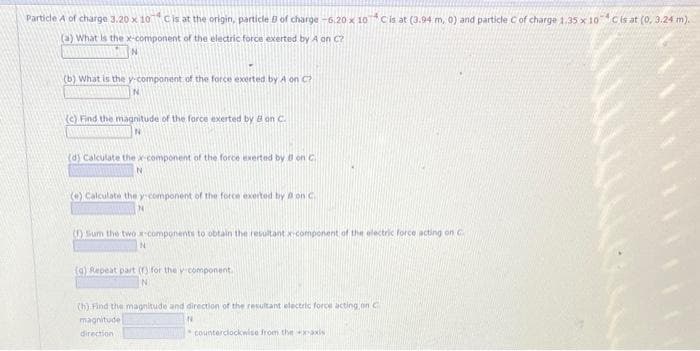Particle 4 of charge 3.20 x 10 C is at the origin, particle 8 of charge -6.20 x 10 *C is at (3.94 m, 0) and particle C of charge 1,35 x 10*C is at (0, 3.24 m). (a) What is the x-component of the electric force exerted by A on C? N (b) What is the y-component of the force exerted by A on C? N (e) Find the magnitude of the force exerted by Bon C. N
Particle 4 of charge 3.20 x 10 C is at the origin, particle 8 of charge -6.20 x 10 *C is at (3.94 m, 0) and particle C of charge 1,35 x 10*C is at (0, 3.24 m). (a) What is the x-component of the electric force exerted by A on C? N (b) What is the y-component of the force exerted by A on C? N (e) Find the magnitude of the force exerted by Bon C. N
Related questions
Question

Transcribed Image Text:Particle A of charge 3.20 x 10 C is at the origin, particle 8 of charge -6.20 x 10*C is at (3.94 m, 0) and particle C of charge 1.35 x 10C is at (0, 3.24 m).
(3) What is the x-component of the electric force exerted by A on C?
(b) What is the y-component of the force exerted by A on C?
(e) Find the magnitude of the force exerted by Bon C.
(d) Calculate the x-component of the force exerted by Bon C
N
(e) Calculate the y-component of the force exerted by on C.
N
(1) Sum the two x-components to obtain the resultant x-component of the electric force acting on C
N
(g) Repeat part (f) for the v-component.
(h) Find the magnitude and direction of the resultant electric force acting on c
magnitude
N
direction
counterclockwise from the axis
Expert Solution
This question has been solved!
Explore an expertly crafted, step-by-step solution for a thorough understanding of key concepts.
Step by step
Solved in 6 steps with 1 images
